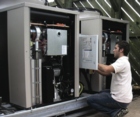Absorbing the facts on gas-fired heat pumps

How does a 50%, at least, improvement in the efficiency of using gas sound? That is the capability of gas-fired absorption heat pumps, as Mike Wheeler explains.
Unrelenting pressure on the building-services sector to deliver heating and hot water solutions with ever-increasing system efficiencies has led to an ignition of interest in gas-fired absorption heat pumps (GAHP) due to their potentially high efficiencies and low environmental impact.
Many people will be surprised to learn that GAHP technology has been around since the late 18th century, while the development of the modern gas-fired chiller is largely due to work carried out on domestic refrigerators by Albert Einstein — yes, the Albert Einstein — in the 1920s.
However, the real leap in technology has happened over the past five years or so with the development of heat-recovery and heat-pump products. Because of these advances, GAHP can now be successfully utilised in schemes that would traditionally use boilers for space heating; they also offer the choice of heating or cooling — or both together.
The current zeitgeist sees specifiers moving away from merely focusing on appliance efficiency to looking at overall system efficiency and lifetime environmental impact. This trend is partly driven by the demands of the Eco-Design of Energy Using Products (EuP) Directive, which demands high minimum system efficiencies within two years of its introduction (in the next three years). Another major driver in the UK is the need to work towards zero-carbon homes in 2016 and zero-carbon non-domestic buildings in 2019.
GAHPs fit the bill completely in this respect as they can produce hot water for heating at efficiencies of over 140%, which gives them one of the lowest carbon footprints of any domestic, commercial or industrial heating device available today. The secret is, of course, using the absorption cycle to extract heat from ambient air or the ground.
GAHPs can directly replace gas-fired traditional and condensing boilers as they can reach temperatures of 70°C. The efficiency of a GAHP is measured by its gas-utilisation efficiency (GUE) — the ratio of the energy it supplies to the energy consumed by the burner. Calculated from the output/input ratio, the efficiency of GAHP's is significantly better than that of traditional or condensing boilers.
Heat pumps do not generate heat in the same way that a gas-boiler burns gas to generate heat – they are devices that use a closed loop fluid circuit to move heat from one place to another. Heat pumps can provide heating or cooling or even heating and cooling from the same unit.
A simple absorption heat pump contains most of the components that you would find in a conventional vapour compression device but the ‘driving’ heat for the absorption machine can be in the form of hot water, steam or even direct firing by gas.
Unlike vapour-compression heat pumps that use environmentally harmful HFC refrigerants as their working fluid (some of which have a global-warming potential over a thousand times greater than CO2), absorption machines use one of two environmentally benign working fluid/absorbent ‘pairs’ — ammonia/water or water/lithium bromide.
The installation and maintenance of GAHPs must be undertaken by qualified installers to ensure efficiencies are achieved and maintained. For example. It is important that all calculations are accurate to achieve and maintain energy savings. The externally sited GAHP will feed hot water into a low-loss header, which will supply radiators, underfloor heating etc. Accurate calculations are needed to guarantee the right flow or the system will not perform to its best.
Taken all in all, GAHP systems are a viable alternative to traditional heating systems and they are increasingly being recognised by specifiers in both domestic and commercial projects. This recognition is due to GAHPs’ ability to produce hot water for heating and generate 30% less CO2 than comparable gas-fired boilers or electric heat pumps. Running costs are also correspondingly frugal.
For comparison, to deliver an output of 38 kW, a condensing boiler would require a gas input of 42 kW compared with just 25 kW for gas-absorption air- or ground-source heat pumps.
Mike Wheeler is with Shorts Environmental.








